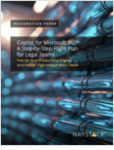The long-awaited California Supreme Court decision in Brinker Restaurant Corporation v. The Superior Court of San Diego County came down on April 12, 2012, ending speculation concerning some of the most heavily contested wage-and-hour issues of the past decade.
Since the adoption of monetary penalties against employers for violations of meal and rest break laws in 2000, California has seen an unprecedented surge in employee class actions, in which plaintiffs have taken full advantage of employers’ rampant confusion about the state of the law. Every major hotel brand operating in California has felt the sting of these “gotcha” class actions, often despite good-faith efforts to navigate the maze of California labor laws.
With the Supreme Court in Brinker holding that employers are not required to “ensure” that their employees take meal breaks, this confusion has now come to an end. Or has it?
The California Supreme Court affirmed the Court of Appeal’s decision that an employer is not obligated to “ensure” that its employees take their meal breaks but merely to “provide” a 30-minute meal break, leaving the decision whether or not to avail themselves of meal breaks to the employees’ discretion.
The Supreme Court clarified that an employer “satisfies this obligation if it relieves its employees of all duty, relinquishes control over their activities and permits them a reasonable opportunity to take an uninterrupted 30 minute break, and does not impede or discourage them from doing so.” P. 36 (emphasis added). It appears at first glance that the court has arrived at a common-sense interpretation of the law that balances the interests of all concerned. The ruling is a victory of sorts for California employers, who have been operating under an ill-defined set of rules and the threat of a more restrictive obligation, but it is also a victory for workers who have retained the right to choose for themselves. It avoids a paternalistic “father knows best” approach towards employees (urged by plaintiffs’ counsel) that would have had employers “ensuring” that their employees ate their meals—for their own good—whether they wanted to or not. While this is a good result, employers are not out of the woods yet.
Here’s the catch: One can readily imagine a conscientious, hard-working employee who chooses to work through meal breaks boasting higher productivity rates and, consequently, being promoted ahead of his or her peers. This raises the question: Can an employer safely reward employees who consistently choose to work through lunch, above employees who do not? Would advancement of employees who skip their meal breaks tend to implicitly discourage other employees from exercising their right to take their breaks, thereby exposing their employers to liability?
The likely answer is that if a plaintiff were able to demonstrate that employees who skip their meal breaks are consistently promoted ahead of employees who take their meal breaks, the employer may be in violation of the law.
As a practical matter, employers should develop clear policies not only about providing meal breaks, but also about the effects of employees’ decisions to voluntarily skip their breaks on career advancement and salary bumps, as follows:
- Mum’s the word: Employers should develop protocols that protect against even the appearance that an employee’s decision to work through breaks is a factor in the employer’s decision to promote or bump up compensation; department heads should blind themselves to productivity as a function of working breaks, and even refrain from commenting on their employees’ decision to forgo meal breaks. Ironically, in this instance, willful blindness may be the only way to ensure compliance with the law; and
- Reasonable productivity benchmarks: Benchmarks for productivity should be consistent with industry standards and the company’s overall brand, and set reasonable expectations that do not require employees to skip lunch. It is imperative that an employee should be able to achieve these benchmarks (and be eligible for advancement and salary bumps) without forgoing meal breaks. In the absence of reasonable productivity benchmarks, industry peer-equivalent data could be levered by plaintiff’s counsel to establish that expectations are unreasonable and effectively “discourage” employees from taking meal breaks.
In sum, the Supreme Court has issued a thorough and thoughtful opinion that clarifies several key aspects of the law relating to class certification as well as the timing and frequency of rest and meal breaks. However, Brinker raises new and perhaps unintended complications for employers as well. Employers would do well to ensure that they do not inadvertently “discourage” their employees from exercising their right to take breaks by favoring those who forgo them. Employers should develop policies that render an employee’s decision to work through lunch irrelevant to his or her advancement opportunities.
Peter Benudiz is co-chair of the gaming and hospitality practice at Milbank, Tweed, Hadley & McCloy in Los Angeles. Anat Sideman is a senior litigation associate in Milbank’s Los Angeles office, specializing in hospitality matters. The firm’s litigation team represents hotel owners and operators in complex contract disputes.
Timing and Frequency of Rest Periods
This content has been archived. It is available through our partners, LexisNexis® and Bloomberg Law.
To view this content, please continue to their sites.
Not a Lexis Subscriber?
Subscribe Now
Not a Bloomberg Law Subscriber?
Subscribe Now
LexisNexis® and Bloomberg Law are third party online distributors of the broad collection of current and archived versions of ALM's legal news publications. LexisNexis® and Bloomberg Law customers are able to access and use ALM's content, including content from the National Law Journal, The American Lawyer, Legaltech News, The New York Law Journal, and Corporate Counsel, as well as other sources of legal information.
For questions call 1-877-256-2472 or contact us at [email protected]





